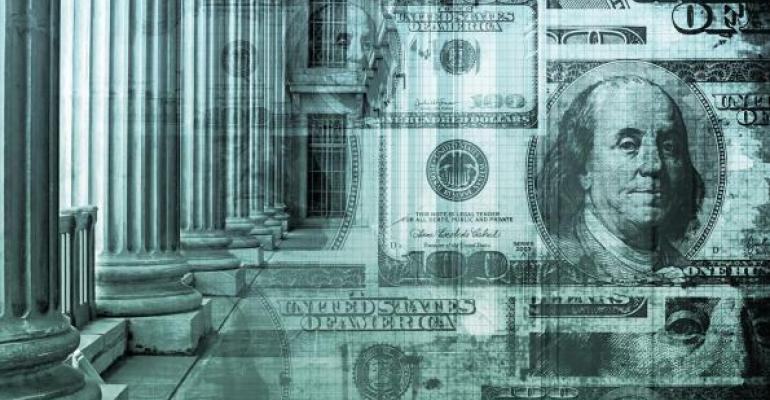(Bloomberg Opinion) -- If you think high-yield savings accounts offer juicy rates to park some cash, wait until you see what money-market funds are paying.
Yields paid by the typically staid mutual funds, which invest mostly in short-term government bonds, spiked from 0.02% earlier this year to more than 3.6% as of early December, according to Crane Data’s 100 money-market fund index. After this week’s rate increase by the Federal Reserve, money-market fund yields are poised to soar even higher.
Some funds, such as Allspring Money Market Fund, Goldman Sachs Investor Money Market Fund and JPMorgan Liquid Assets Money Market Fund, are already offering yields close to 4% or more.
That compares with a 3% average payout for a high-yield online savings account. Although that’s the highest in at least five years, banks haven’t exactly kept pace with the Fed’s interest-rate increases since May.
That’s because the rates offered by banks are ultimately at their discretion and influenced by factors other than the Fed’s moves. The biggest banks are still flush with pandemic cash so have barely budged from what they’re paying depositors on their savings accounts. (The average for all banks was 0.24% as of Nov. 21, according to the Federal Deposit Insurance Corp., but if you bank at say, Wells Fargo or Chase, you’re lucky if you get 0.02%.)
Online banks are more eager for customer deposits so have been more responsive at passing on the Fed’s rate increases to their customers. Still, given that money-market funds are investing mostly in Treasuries, their yields tend to move in lockstep with the Fed’s rate. “Money funds always give the market what the Fed gives them,” said Pete Crane, founder of Crane Data.
Money-market funds are often used to safeguard cash that could be needed on short notice, such as for a home down payment or an emergency fund, or as a holding spot between portfolio investments. Given the funds’ attractive yields, more investors should be giving them a second look.
Some already are. Money-market funds have been reeling in assets since April, hitting $4.72 trillion this month — close to the record high of $4.79 trillion in May 2020, according to the Investment Company Institute.
Remember though, money-market funds aren’t synonymous with bank accounts. They don’t have FDIC insurance, and there have been instances where assets have dipped below $1 a share, or “broke the buck,” and customers couldn’t get all their money back.
That’s less of an issue now after regulatory reforms adopted as a result of the fallout of the 2008 financial crisis. In addition, most money-market funds just hold government bonds that are backed by the full faith and credit of the US government. In the past, the funds that got into trouble invested in short-term corporate bonds.
Still, investors for whom safety is the No. 1 concern should stick with money-market funds that invest solely in government paper, not corporate bonds. The fund name will usually specify what it’s investing in, but check the fund documents to be sure.
Of course, other cash-like investments are also offering high yields (relatively speaking) — looking at you short-term sexy Treasury notes — but it may be more difficult to access your cash than with money-market funds. You can schedule and stagger short-term purchases of certain duration T-bills on TreasuryDirect.gov, but that takes a little more legwork than just buying some money-market fund shares directly.
It’s a similar story with certificates of deposit — they offer potentially higher yields, but investors must commit to locking up their cash for a set period.
For those whose brokerage firms offer money-market funds alongside their accounts as a place in which to “sweep” excess cash, beware. Those funds rarely have the best yields, said Ken Tumin, founder of DepositAccounts.com. If you have a large balance, you should consider switching to a different money-market fund that offers a bigger payout.
Keep an eye on fees, though. Unlike a bank account or a Treasury bill, money-market funds charge for managing your money. When yields were abysmally low, many money funds waived most of their fees, charging an average 0.08% instead of the typical 0.27%, Crane data shows. But with higher yields, fees are back to normal levels.
Finally, if you’re in a high tax bracket, consider money-market funds that invest in municipal bonds, which provide interest that could be exempt from federal or state income taxes. Their yields aren’t quite as high as other money-market funds right now, but Crane says it’s only a matter of time before they bounce back. They tend to see big outflows at the end of the year and on April 15, so as prices fall, yields will head north.
More From Bloomberg Opinion:
- Not Even AI Is Able to Beat the Market These Days: Aaron Brown
- Forget What You’ve Learned About Investing: Merryn Somerset Webb
- Gen Z Has It a Lot Harder Than Millennials: Allison Schrager
Want more Bloomberg Opinion? OPIN <GO>. Or you can subscribe to our daily newsletter.
To contact the author of this story:
Alexis Leondis at [email protected]





